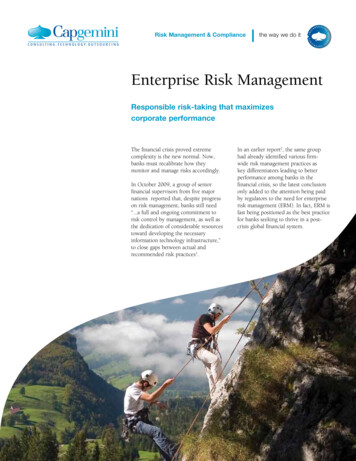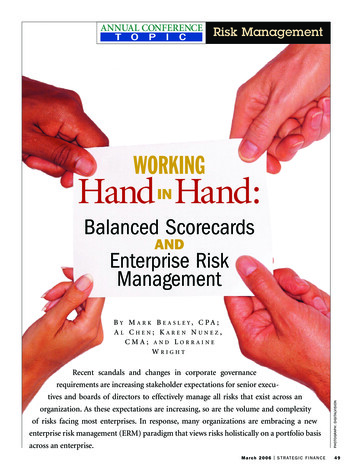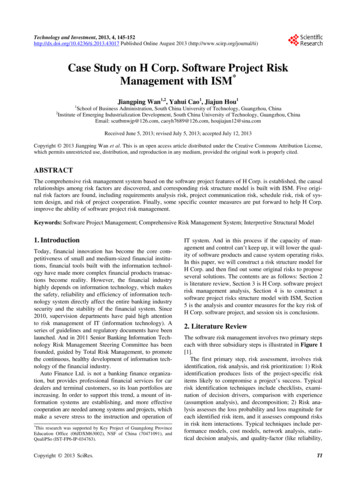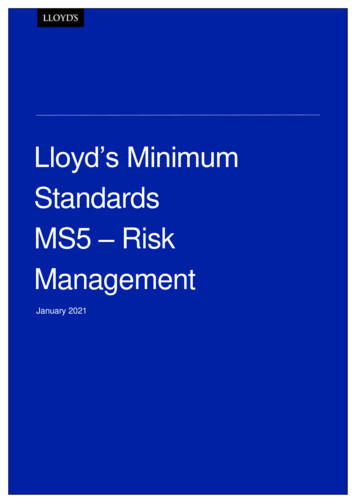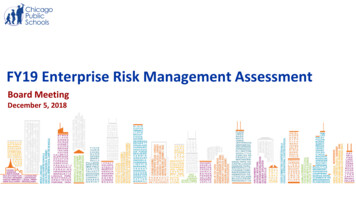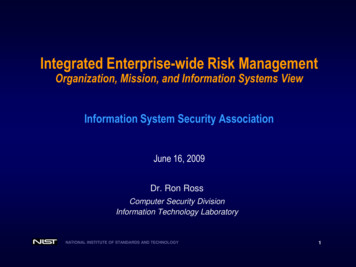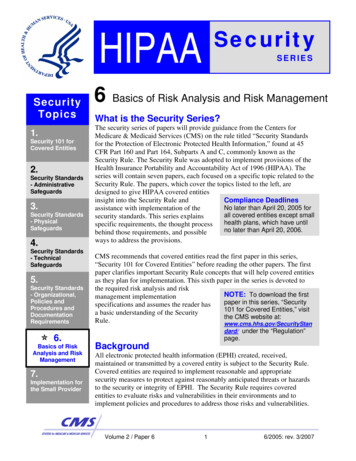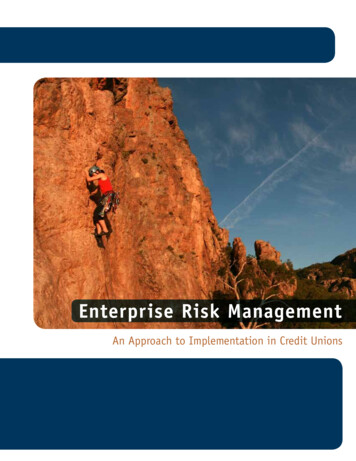
Transcription
Enterprise Risk ManagementAn Approach to Implementation in Credit Unions
AcknowledgementSpecial thanks to the members of the Colorado Credit Union Working GroupOn ERM—a group of seven credit unions in the state of Colorado (both stateand federally chartered) that developed this white paper in order to shareinformation on best practices related to Enterprise Risk Management (ERM).The working group would like to extend their thanks to the Credit UnionAssociation of Colorado, SunCorp and RSM McGladrey, Inc. for theirsupport in the development and distribution of this white paper.Colorado Credit Union Working Group On ERMScott CollinsChief Financial Officer, Credit Union of DenverTony FerrisRochdale Group Consultants—Bellco Credit UnionBetsy GuerreroChief Financial Officer, Westerra Credit UnionSchwan HardiInternal Audit and Fraud Manager, Credit Union of ColoradoCyndi KoanExecutive Vice President, Public Service Credit UnionWanda MatsudaVice President, Enterprise Risk Management & Compliance, Westerra Credit UnionClint SchneiderVice President, Chief Audit & Risk Officer, Ent Federal Credit UnionMichelle TygartStaff Attorney/Assistant Vice President, Enterprise Risk Management, Public Service Credit UnionCarol WardVice President, Enterprise Risk Management, Elevations Credit UnionDavid E. Maus (Working Group Sponsor)Chief Executive Officer, Public Service Credit Union
Table of ContentsWhy ERM?1ERM Overview—“The Basics”2Move from “Current State” to Desired ERM Culture4Risk Assessment5Risk Management/Monitoring/Reporting8Exhibit 1: ERM Maturity Model11Conclusion12Glossary13Other Resources15Appendices16Appendix ASample16Appendix BSample ERM Board Policy (1)17Appendix CSample ERM Committee Charter17Appendix DSample Risk Assessment Rating System19Appendix ESample Risk/Heat Map20Appendix FSample Risk Matrix for Monitoring/Reporting20Appendix GSample Seven Risk Domains Dashboard23
Enterprise Risk Management PAGE 1Why ERM?Some believe that, in many organizations, management of risk is too focused on operational and complianceissues, and, therefore, fails to identify and monitor emerging strategic risks that could affect long–term viability.Others believe risk management is too unstructured, resulting in overall weaknesses in managing risk.Whichever the case, we know the evolution of ERM in creditunions is ongoing and dynamic. This document is designed toeducate and provide guidance to credit unions as they evaluateoptions and opportunities to develop their ERM approach andculture. Concepts from a document entitled Enterprise RiskManagement–Integrated Framework, developed by the Committeeof Sponsoring Organizations of the Treadway Commission (COSO),were used for many core elements in this paper. Recognizedas the leading guidance on Enterprise Risk Management, thedocument provides a framework to identify, assess and managerisk, and can assist boards and management in understanding anenterprise–wide approach.What is Enterprise Risk Management?Fundamentally, credit unions are in the business of managingrisk. Examples include asset liability management, vendormanagement, business continuity planning, auditing, strategicplanning, and project management. In most credit unions, theserisks tend to be managed individually, in a silo approach; andwhile an effective ERM program does not replace these existingrisk management practices, it can serve to form a commonsharing of risk–related information resulting in a comprehensiveview of risk across the organization. This creates increased transparency and understanding of all risks organization–wide, andallows for gaps in risk management to be identified. SuccessfulERM programs, therefore, result in credit unions assessing risksglobally, with a forward–looking perspective, resulting in moreeffective risk management on an enterprise–wide basis.Enterprise Risk Management is not: A finite project or a one–time event. A risk checklist, spreadsheet to complete or a softwareprogram to implement. A risk audit, audit of controls or compliance assessment. One individual’s job or responsibility.Enterprise Risk Management is a collaborative process to identify,manage and monitor organizational risks and opportunities,both internal and external, to ensure achievement of the creditunion’s strategic objectives and continued financial stability andviability. It is more than just identifying control weaknesses;rather, it facilitates identification of potential events that, ifthey were to occur, could result in negative or damaging consequences for the organization. It is also designed to ensure thatrisk is managed within the credit union’s appetite or tolerancelevel. The goal of ERM is not to eliminate risk. Instead, aneffective ERM process will create an environment where risk isembraced and allows the board and management to make holistic,“risk–intelligent,” strategic decisions. ERM, therefore, is a strategic tool rather than just a compliance tool.What are the Benefits to Credit Unions?A comprehensive ERM program will: Provide a comprehensive view of organizational risk, anda framework to consider how risks interrelate, resulting inenhanced decision–making. Improve communication and result in deeper, richer discussions about risk throughout the organization, thus positioningthe credit union to take advantage of opportunities. Establish a philosophy regarding risk and a risk culture,including aligning risk appetite and strategy, allowing forrisk optimization within defined risk tolerance levels. Allow management to identify and deal effectively withemerging risks, thus reducing surprises and potential losses. Facilitate effective allocation of resources via risk/rewardanalysis, elimination of redundant risk management activities, and identification of process improvement opportunities.What Makes an ERM Program Successful?The keys to a successful ERM program include: Obtaining board and management buy–in and activeinvolvement. Beginning with a simple approach, focusing on identifiedproblem areas, and allowing the program to evolve over time. Establishing realistic expectations for implementation.Immediate success is rare; ERM must be viewed as a long–term cultural change. Realizing that there is not a “one–size–fits–all” approach;but, rather, a progression and maturity based on the sizeand complexity of the credit union. Focusing on material risks to avoid getting bogged down. Assigning an individual or team to “champion” the initiativeand ensuring they are provided with adequate time, supportand resources to focus on the initiative. Working in conjunction with the credit union’s overallstrategic plan and organizational culture, ensuring thatorganizational goals, strategies and products are consistent
PAGE 2Enterprise Risk Managementwith risk tolerances that have been established by the boardand senior management.Board Fiduciary ResponsibilityRegulatory expectations of effective risk management require aninformed board of directors to guide the credit union’s strategicdirection, within the parameters of its risk tolerances. The boardof directors has a fiduciary responsibility to understand the riskposition of the credit union and to understand how the strategicdirection they are setting impacts the credit union’s risk position.Regulatory expectations are that risk–monitoring systems, whichenable the board to hold management accountable for operatingwithin risk tolerance levels and require that managementactively informs the directors of material risks, are in place.Regulator ExpectationsNCUA letters to credit unions have risk management at thecore of their message. They outline regulators’ expectations foreffective risk management. An effective ERM program, therefore,proactively incorporates the risk concepts and messages deliveredin NCUA letters to credit unions.The guidance from regulators, to adopt an institution–wideERM program, is a challenge to most credit unions’ conventionalbusiness models. Credit unions, as well as other financial institutions, traditionally look to financial indicators (commonly referredto as “lagging indicators”) to make strategic decisions. This methodology has been very successful; however, the current economicenvironment, along with the changed expectations of regulators,requires financial institutions to anticipate future risks in orderto survive. Identifying and assessing emerging risks through theuse of leading indicators, to make both business and strategicdecisions, is key to a successful ERM program.ERM Overview—“The Basics”A successful ERM program is a forward–thinking approach that allocates resources to the areas exhibiting weaknessor adverse trends. Practical application requires implementation from the top down. The credit union’s board ofdirectors must adopt the vision of the program, as well as a comprehensive policy, which must then be supportedby the senior management team, and implemented organization–wide through active committees, procedures andinternal controls. Employing sufficient staff, with access to necessary resources, is also integral to the process.Getting StartedEffective integration of risk management activities, that are inline with both strategic initiatives and regulatory expectations,can be a daunting task for any organization. This section willoutline a basic framework and implementation plan, followed bysome concepts to consider and address as the plan is developed.Subsequent sections will elaborate on these topics and providepractical examples of the concepts presented in the overview andthe steps touched on in this section.Common CharacteristicsFrom a practical standpoint, the actual scope, roles and desiredERM culture (or model) should be commensurate with the sizeand complexity of the credit union. However, it is anticipatedthat certain “best practices” will be employed in developing andimplementing an effective ERM program. These common characteristics include performing an initial evaluation; developingan action plan; identifying, measuring and monitoring risk; andperiodically evaluating the effectiveness of the process, visionand integration throughout the organization.Initial EvaluationThe first step in implementing an effective ERM program isfor management and the board of directors to jointly assess theexisting risk management process, evaluating its effectivenessand identifying its deficiencies in order to develop a shared vision.Based on the size and complexity of the credit union, some willlikely be further along the ERM Maturity Model spectrum thanothers. (A sample ERM Maturity Model can be found in Exhibit 1on page 19.) A key component of the vision is buy–in and supportfrom the board of directors and senior management.
Enterprise Risk Management PAGE 3Action PlanManaging/Monitoring/ReportingOnce the assessment is completed and an ERM vision is formed,senior management, in conjunction with the board, shoulddevelop an appropriate action plan to implement the vision. Thisplan should address expected timelines and assign duties to theindividuals who will be responsible for moving the vision forward.Some credit unions have found it beneficial to designate a RiskOfficer1 and form a cross–departmental, risk management orrisk oversight committee. The roles of the Risk Officer and thecommittee should be clearly defined and be consistent with theoverall ERM vision and corporate culture.Reports, conveying the risk associated with each of the corerisk domains, should be generated periodically, for the boardand senior management. Policies and procedures that identifyfrequency of reporting, types of reports to be generated, appropriate risk tolerances, and adequate mitigation measures shouldbe developed.Risk AssessmentAt a minimum, an effective ERM program should assess the riskassociated with the following seven risk domains defined by NCUA: Strategic RiskTransaction RiskCredit RiskInterest Rate Risk Liquidity Risk Compliance Risk Reputation RiskFor each domain, the assessment should define the key metricsthat will be used to evaluate the risk, develop a risk profilefor each metric, and track these metrics over time. The actualmetrics that will be measured will vary depending on thespecific needs of the credit union; however, best practicessuggest that there should be more than one metric for each riskdomain. Ideally this process would not only measure current riskprofiles, but also provide early warning indicators to identifyemerging risks as well. In defining and developing the metricsand their profiles, it may be helpful to perform a risk assessmentto inventory risks related to each domain. This will help todetermine from where the organization’s risks are originating. Ingeneral, a risk profile would include: Developing probability and impact assessments; Identifying inherent and residual risk (impact on earningsand capital); Tracking the metrics over time and classifying bothdirection and magnitude of risk; and Developing appropriate action plans.1 Best practices implementation does not require the Risk Officer to be a separate position. It isacceptable to assign the duties to an existing employee or outsource some or all of the responsibilities as long as it meets the needs of the credit union.In addition, emerging risk evaluation and discussion shouldbe integrated into the reporting and monitoring process. Theboard and management should proactively measure and discusspotential risks to the organization based on changes in both theinternal and external environment.Re–evaluateAs mentioned previously, an ERM program is not a static project.Changes in the size and complexity of the credit union, as well aschanges in risk tolerances over time, dictate that it be dynamic.Periodically, management and the board should perform newself–assessments to ensure their program is both, appropriate andeffective, and to make necessary adjustments and enhancementsas warranted.While larger, more complex credit unions will generally visualizeand develop ERM programs that are more robust and furtheralong the risk maturity model spectrum, a best practice of anyERM program should be to communicate the expectation of riskawareness and evaluation across the entire organization.The first step in implementingan effective ERM program is formanagement and the board ofdirectors to jointly assess the existingrisk management process, evaluatingits effectiveness and identifying itsdeficiencies in order to develop ashared vision.
PAGE 4Enterprise Risk ManagementMove from “Current State” toDesired ERM CultureInitial EvaluationFrom Evaluation to ERM CultureThe ERM implementation process begins with the board ofdirectors performing a self–assessment of the current environment. This initial evaluation should, at a very high level,determine where the directors, senior management and theorganization, overall, are in understanding roles and responsibilities as they relate to ERM. The initial evaluation can also helpto identify where, in the ERM Maturity Model, the credit unioncurrently operates. A high–level evaluation could be completedusing an assessment tool, such as the sample questionnaireprovided in Appendix A. Significant components of the initialevaluation might include:Once the board and senior management have completed theinitial evaluation, there should be a good understanding of thecredit union’s risk management philosophy, and whether thereis uniform understanding between senior management anddirectors regarding risk tolerances, roles/responsibilities for riskmanagement, and ongoing oversight and monitoring. Alignment of Board of Directors and Senior Management—This includes the willingness to accept risk, the integrationof risk appetite into strategic planning, and the understanding and agreement regarding high level/key mitigationstrategies and tactics as defined by board–approved policies.Upon completion of the initial evaluation, the credit union’sformal and informal policies, processes, practices and riskmanagement techniques should be identified. Senior management’s next step is to develop the guiding vision for theevolution to the desirable future state of ERM. As with any strategic planning effort, formulation of an ERM vision should guidethe creation of specific business objectives designed to pave theway to a desirable ERM culture that will be endorsed by seniormanagement and the board of directors. Assessment of Communication on Risk between Boardand Senior Management—Can it be described as transparent, effective, informative, clear, candid and timely? Sufficiency and Effectiveness of Key Risk Measures/Metrics—Are they adequate in providing an understandingof current and changing risks, as well as management’s riskperspective and remediation of significant weaknesses? Assessment of Use of Early Warning Indicators—Are theyused by senior management and, where appropriate, theboard to identify and monitor risk?“Risk tolerances are the acceptable levels of variation relative to theachievement of objectives Operating within risk tolerances providesmanagement greater assurance that the entity remains within its riskappetite, which, in turn, provides a higher degree of comfort that theentity will achieve its objectives.” COSO ERM Integrated FrameworkDefining the ERM ProgramAn ERM program should encompass management’s assessment ofthe people, technology and process capabilities already in placeand functioning, as well as promote the new capabilities thatthe credit union may need to develop. It may acknowledge theOver time, the initial ERM program should beupdated and enhanced periodically in order toensure that it continues to keep pace with theevolution of the credit union’s strategic plan, andwith emerging internal and external risks.
Enterprise Risk Management PAGE 5current state of ERM development within the credit union andshould also provide the direction to move to a more mature modelwithin a given time period. Once the program is defined, specificbusiness objectives should be developed to support implementation through analysis of roles/responsibilities and modificationsto organizational governance structure and processes. Thisincludes implementation or modification to policies, procedures,processes, methodologies, tools, techniques, information flows,communications and technologies.Developing and Implementing Action PlansKey ERM business objectives should be supported by specific,actionable implementation plans. At a minimum, an ERM programshould include consideration of deployment plans, trainingsessions, reinforcement mechanisms, and monitoring/re–evaluation for success of all major segments.While not a regulatory requirement, credit unions are encouragedto establish some form of ERM governance, such as a riskmanagement/oversight committee. Committee coordination cangreatly facilitate a single framework for managing risk, anda common language and tools for implementation across thecredit union. The structure of this committee should be tailoredaccording to the culture of the credit union. For example, asample charter for a cross–departmental ERM committee isprovided in Appendix C. In contrast, in Appendix D, there is asample Risk Oversight/ERM Committee Charter describing theresponsibilities envisioned for a committee comprised of seniorexecutives. These are illustrative examples provided to encouragecreative development of an appropriate oversight structure thatmay be unique to each credit union.Over time, the initial ERM program should be updated andenhanced periodically in order to ensure that it continues to keeppace with the evolution of the credit union’s strategic plan, andwith emerging internal and external risks. Key roles/responsibilities and governance infrastructure may need to be refinedor refocused. At the outset of this project, senior managementshould establish project milestones and provide targeted opportunities for reassessment of the program’s implementation efforts.Risk AssessmentImportance of the Business ModelThe cornerstone of an ERM program is the credit union’s businessmodel. The business model should define activities the creditunion will undertake, the products and services it will provide,how it will conduct business, and in which markets it will operate.It should define the vision, mission and values, and it should beconsistent with the credit union’s appetite for risk.To ensure the credit union’s ongoing success, senior managementmust determine and articulate the barriers and uncertaintiesinherent in the business model. These barriers and uncertaintiesconstitute risks.Conducting a Risk AssessmentTo effectively understand and manage these risks, the creditunion should conduct a risk assessment. Failure to perform aneffective risk assessment increases the likelihood that the creditunion will be unprepared to anticipate or manage risk occurrences that could adversely affect the achievement of goals and,more significantly, earnings and net worth.Capital, or net worth, constitutes the reserve of funds availableto manage and absorb risks to the institution. In the broadestsense, the amount of capital a credit union has accumulated is animportant determinant of the amount of risk it can assume.Although a variety of approaches can be used to conduct a riskassessment, each approach generally contains the followingcomponents: Business Model—A comprehensive understanding of thecredit union’s business model (i.e., strategic plan, products,services, business lines/processes and functions, etc.). Inherent Risks—Awareness of the inherent risks associatedwith credit union services and operations (e.g., credit risk,interest rate risk, transaction risk, reputation risk, liquidityrisk, etc.). Risk Identification—Identifying events that may have anegative impact on the credit union and the achievementof its business objectives, on and off its balance sheet. Analysis and Prioritization—Risks must be evaluatedusing a scoring system to measure likelihood and impact ofoccurrence, etc. Awareness of risk management systems, i.e.,strategies, internal controls, monitoring and reporting, tomanage risk to an acceptable level in accordance with boardof directors and senior management tolerance criteria.There can be many levels of risk assessments, ranging from abroad assessment of the credit union (enterprise level) to amore focused assessment of a business product, unit or function(business level).
PAGE 6Enterprise Risk ManagementEnterprise Level AssessmentA logical starting point in the risk assessment process is toconduct an enterprise level risk assessment for the credit union.This can then lead to, and be followed by, risk assessments at thebusiness unit or process level. The primary focus and goal of theenterprise level assessment is to establish an initial high levelbasis for determining whether the credit union has reasonablyeffective risk management practices throughout the credit union,and to identify any significant inherent risks requiring immediate and/or additional mitigation efforts. The desired outcomeof the enterprise level risk assessment is to establish a basis fordetermining that: Management has processes for identifying, assessing andmanaging top risk exposures related to core strategic objectives. Risks being taken in pursuit of objectives are effectivelymonitored to ensure they are within acceptable levels withinthe defined risk appetite of the credit union. Management has processes in place to identify emergingrisks and related changes in risk prioritization in a rapidlychanging environment.The process first involves reviewing the credit union’s strategicplan and identifying key strategic objectives that furthertranslate into business initiatives and goals integral to the creditunion’s success. Next, select the most important elements ofthe credit union’s strategy and goals and align with the seniormanagement and related business units that are primarilyresponsible for achievement of the goals. Pertinent questionsthat may be asked at this time are: (1) why are these initiativesimportant to the success of the credit union, (2) which of theseinitiatives are most important and, (3) what risk managementinformation is available? An initial determination should alsobe made as to which of the internal and external inherent riskfactors associated with the credit union industry, e.g., credit risk,interest rate risk, liquidity, reputation risk, transaction risk, etc.,may present material barriers to achievement of strategic and/orbusiness unit objectives.Through interviews, surveys or cross–functional meetings withsenior and line management, specific material risk events thatmight arise from the risk factors identified can be discussed anddocumented. Examples of questions that could be asked to spurdiscussion and brainstorming to identify risks include: What are the greatest risks, inherent and emerging, thatcould keep the credit union from achieving its strategicobjectives? What processes help identify these? What assumptions are integral to the credit union’s strategicplan? What if those assumptions are incorrect? What internal or external risks, if not effectively managed(controlled or monitored), would have a significant impactto the credit union’s strategy, earnings, reputation, etc.? Can management tolerate the risks if they were to occur ata significant level of impact? Where are opportunities within the credit union to improverisk management?At this point an initial determination should also be made,largely based on management’s opinion, as to the potentiallikelihood and impact of the identified risk events occurring,and then evaluating the effectiveness of mitigation and controls.A scoring system, rating likelihood and impact factors, lessa mitigation–effectiveness score that rates control strength,could be applied against an inherent risk score—one that rateseffectiveness of controls, processes or other mitigation strategies.This could be the standard framework for ultimately determiningresidual risk. (See the Response Effectiveness Rating criteria referenced in Appendix E.) The residual score for risk items can thenbe reviewed to determine where risk mitigation efforts are bestfocused to get the most risk–reducing impact. Creating a risk heatmap (see Appendix F) by graphing each risk, based on its probability and impact, can visually show which risks might warrantfurther review to identify additional risk mitigation strategies.Once the major risks at an enterprise level are identified, analysisshould be completed to ascertain what, if any, risk mitigationplans/strategies, risk tolerance levels and information systemshave been implemented to: (1) monitor and measure the risksagainst strategic objectives, and (2) reduce either the likelihoodor the impact of the risks to the credit union within definedtolerances. Integral to this process is identifying the degree ofmonitoring and the type reports that are available to managecurrent and emerging risks. An initial determination regardingfrequency of preparation and audience distribution should alsobe made to answer the question: “Is timely, relevant, risk information being provided to key decision makers, such as seniormanagement and the board of directors?”The initial enterprise level risk assessment will provide a determination of the credit union’s overall awareness of key strategiesand objectives, the ability to recognize current and emergingrisks, and the effectiveness of current risk management systemsand strategies. This assessment can then be used to furtherevaluate and develop risk mitigation action plans where potentialdeficiencies or limitations with risk management processes andThe cornerstone of an ERM program is the credit union’s business model.
Enterprise Risk Management PAGE 7reporting may have been observed. Mitigation options include: (1)risk transfer, (2) avoidance, (3) reduction, or (4) acceptance. Theassessment also produces documentation of the most importantgoals in the business plan, along with attendant risk factors,specific risks and risk mitigation strategies. This information canbe used to prioritize and conduct a more detailed business levelrisk assessment, taking the same process to the next level ofdetail in the credit union and conducting a functional evaluation.The risk assessment process generally includes thefollowing steps:Risk Identification Organizational Structure—Review and understand thecredit union’s organizational structure and business unit/functional areas (i.e., commercial lending, mortgagelending, loan operations, compliance, operations, IT, cardservices, etc.), including line and senior managementresponsible for the business units or functional areas. Key Processes and Responsibilities—For each business unit/functional area, identify and document key processes andresponsibilities necessary to the area’s accomplishmentof department/business objectives and goals. Referenceresources may include internal audit working—papers/process–flows and information technology data maps. Risk Events—For the key processes and regulatorycompliance areas noted, identify and document, what arebelieved to be, the more significant/material external(economic, natural, political/regulatory) and internal(infrastructure, personnel, process) factors that presentsignificant risks to the achievement of objectives withinall business /functional areas. Other sources available forrisk identification include industry guides, internal auditdocumentation, examination reports, etc. Begin associatingthe risks identified with the applicable regulatory riskdomain(s), such as credit risk, interest rate risk, transactionrisk, etc. This can be done by considering what can gowrong in a business process or compliance area and, then,relating these items to the inherent risk domain definitions. This will lead to, and facilitate, risk aggregationby inherent risk domain and business fun
allows for gaps in risk management to be identified. Successful ERM programs, therefore, result in credit unions assessing risks globally, with a forward-looking perspective, resulting in more effective risk management on an enterprise-wide basis. Enterprise Risk Management is not: A finite project or a one-time event.


